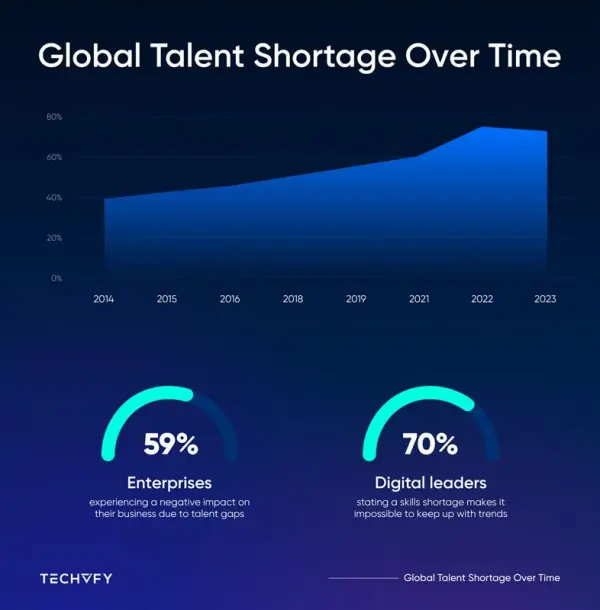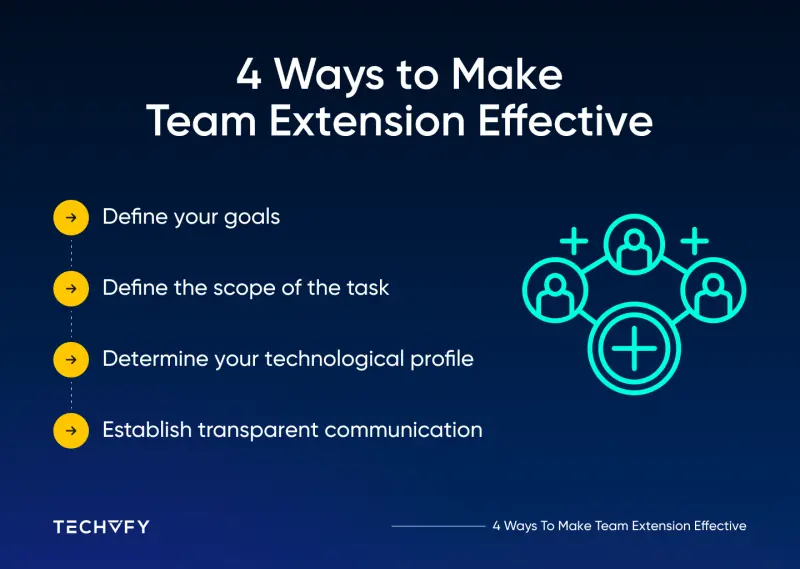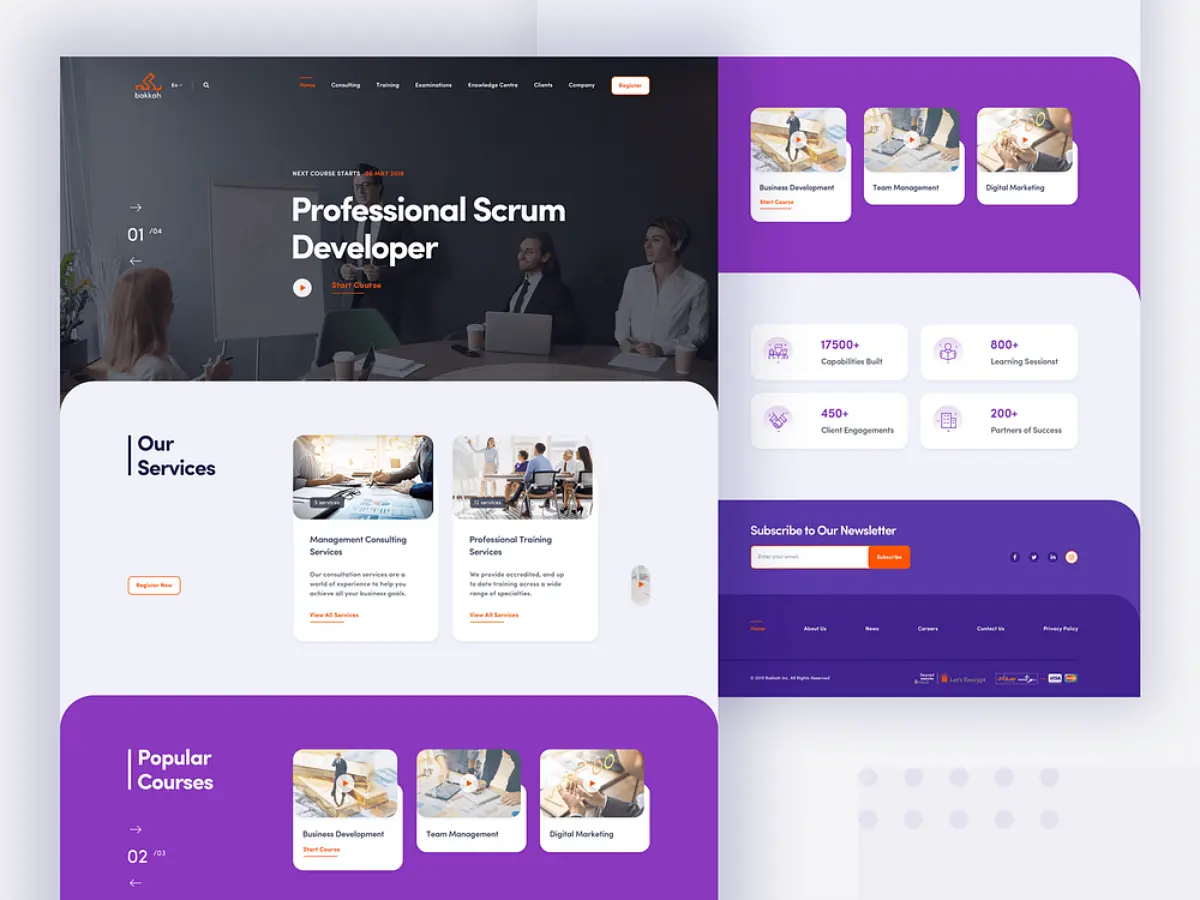Team Extension Explained: How to Access Global Tech Talent Fast
- TECHVIFY Team
- 0 Comments
The need for skilled software and app developers continues to grow every day. That’s why many startups and even well-established businesses turn to software development outsourcing—it offers them a ton of benefits.
Since the demand for expert development teams keeps climbing, both developers and business owners must understand team extension. Deloitte even predicts that global spending on IT outsourcing will reach $917 billion by 2023, showing just how popular this staffing method has become. It helps tech companies meet tight deadlines, find top talent, and deliver high-quality products and services in a competitive market.
Team extension is often confused with the dedicated team model or traditional outsourcing. In this guide, we’ll break down how team extension stands out, its pros and cons, and how it can fit into your growth strategy. Plus, we’ll walk you through the steps needed to build an extended team for your business
I. The Basics of Team Extension
Team extension is all about bringing in expert professionals with specific skills and knowledge to join your existing team, helping boost productivity and speed up processes.
This model is especially useful when you’re launching a new initiative or working on a project that’s racing against a tight deadline. The extended team provides extra support without disrupting the original plan set by your core team.
On top of that, team extension is great for adding new skills or complementing your existing team with valuable expertise that can help scale up the project. Unlike other software development hiring models, team extension is built on long-term partnerships with both the tech team and the hired experts. This approach makes the process reliable, flexible, and cost-effective.
Global Talent Shortage Over Time
How Does It Work?
Team extension involves bringing in external developers who fully commit their time and expertise to your company. At first glance, this might sound like hiring a dedicated team, but they’re not quite the same. A dedicated team usually focuses on one specific project and wraps up their work when the project is done. In contrast, an extended team works more like your permanent employees. They get familiar with your company culture, share your goals, and function as part of your larger team.
How to Manage an Extended Team
Leading an extended team is much like managing your in-house staff. You’ll still be responsible for assigning tasks, coordinating efforts, and providing feedback, just as you would with your own employees. The way you manage the team may vary depending on whether you hire individual freelancers or partner with IT staffing providers. If you choose the latter, you can work with the outsourcing firm to handle recruitment, and onboarding, and make sure the new developers fit seamlessly into your company culture.
II. Significant Benefits of Team Extension
The team extension model offers a variety of benefits that can greatly enhance the success of your business. Here are some of the key advantages:
1. Scalable Team Growth
Scaling a tech team can be a complex process, especially when specific skills are required. The hiring and vetting process can take time, particularly if you’re looking for niche expertise. Team extension helps streamline this by allowing you to scale your team quickly, focusing on the value and skills the extended team brings without the delays of traditional hiring.
2. Enhanced Team Communication
Effective communication is critical to a project’s success. Miscommunication or unclear directions can lead to setbacks and wasted resources. With the team extension model, communication is typically more efficient between the extended team and your in-house staff. Both teams consist of professionals who clearly understand the project’s requirements and can collaborate seamlessly to achieve the desired outcomes.
3. Access to Global Expertise
Team extension opens the door to a global talent pool. Instead of limiting yourself to local candidates, you can search internationally for the best experts to fill gaps in your team. This ensures that your project benefits from top-tier talent, keeping it on track and maintaining high-quality standards.
4. Distributed Responsibility
Sharing the workload between your core team and the extended team can improve motivation and ensure high-quality results, even under tight deadlines. Shared responsibility fosters a sense of collaboration and teamwork, which helps streamline the product development process and ensures everyone is working toward a common goal.
5. Transparent Cost Structure
Unexpected costs are a common challenge in business operations, whether they come from employee benefits, office supplies, or other unforeseen expenses. With the team extension model, costs are clearly outlined upfront. You agree on payment terms with the extended team, making it easier to manage your budget without worrying about hidden expenses.
6. Improved Project Oversight
Effective project management is essential for meeting deadlines and avoiding wasted resources. With the team extension model, you have flexibility in how you manage your project. You can either assign a project manager to oversee the extended team or take on the role yourself. This flexible approach ensures that project oversight remains transparent, organized, and efficient.
7. Greater Market Competitiveness
As the tech industry evolves, staying competitive requires fresh ideas and innovative solutions. The team extension model allows you to bring in skilled professionals with creative insights that can help push your project forward. These experts can introduce new strategies and perspectives, ensuring your products or services remain competitive in the marketplace.
III. Who Can Benefit from Team Extension?
Outsourcing Market that leads to team extension
Team extension provides flexible and scalable advantages across diverse industries, enabling organizations to access specialized expertise, drive innovation, and meet evolving project needs. Here’s a breakdown of who stands to benefit the most:
- Large Corporations
Large corporations can use team extension to improve operational agility and respond swiftly to changing market demands. By enhancing in-house teams with external specialists, they can foster innovation, solve complex challenges, and maintain a competitive edge in dynamic industries. - Startups and SMEs
For startups and small to medium-sized enterprises (SMEs), team extension is a cost-effective way to access the specialized skills needed for rapid innovation and growth. It allows these businesses to scale up quickly without the financial burden of full-time hires, helping them focus on core objectives while developing new products or services. - Healthcare Organizations
In healthcare, team extension can play a crucial role in developing advanced digital health solutions, patient management systems, and telemedicine platforms. By bringing in experts with healthcare technology experience, organizations can improve the quality, security, and efficiency of their digital offerings. - Consulting and IT Services Firms
Consulting and IT services firms can expand and diversify their offerings by utilizing team extension. By incorporating external experts, these firms can better tailor solutions to meet client needs, ensuring higher project success rates and greater client satisfaction. - Non-profit Organizations
Non-profits can leverage team extension to enhance their digital strategies, including donor management systems and online engagement efforts. By integrating external talent, non-profits can optimize their web presence and outreach, helping them achieve their mission more efficiently and reach a broader audience. - Educational Institutions
Educational institutions can improve their digital infrastructure—such as online learning platforms and administrative systems—by extending their teams with external developers. This approach enables more engaging, effective learning environments and helps streamline administrative processes through technological innovation. - eCommerce Brands
Brands operating eCommerce platforms can benefit from team extension by improving website functionality, user experience, and overall digital offerings. External teams bring fresh perspectives and specialized skills, helping brands deliver more engaging and efficient online shopping experiences.
Have a Project Idea in Mind?
Get in touch with experts for a free consultation. We’ll help you decide on next steps, explain how the development process is organized, and provide you with a free project estimate.
IV. How to Hire a Trustworthy Team Extension Partner
Bringing developers on board through a team extension model requires careful consideration because they play a crucial role in your company’s growth. Follow these steps to ensure you hire a reliable partner.
Step 1: Pinpoint Your Requirements
Every business, whether a startup or an established company, has unique technical and operational needs. Dive into the specifics of what you’re trying to build—what kind of app are you developing, and what tech stack is required? Do you need someone who can jump into the project with little guidance? If so, opting for an experienced developer would be better than choosing someone new to the field.
Step 2: Find a Partner That Matches Your Needs
Once you’ve outlined your requirements, the next step is to find the right team extension partner. You can explore various options, such as websites, forums, or professional comparison platforms like Clutch. No matter which route you take, make sure to do thorough research by reading reviews and testimonials from other clients about the software companies you’re considering.
Step 3: Review the Terms of Cooperation
Not every candidate will align with your project’s terms. Factors like rates, qualifications, skills, and communication preferences all matter. Additionally, it’s vital that developers comply with privacy policies and non-disclosure agreements (NDAs). Go through your checklist carefully, and only proceed with a partner who meets all your criteria.
Step 4: Schedule an Introductory Call
Since you’ll likely be working with this partner for a long time, take the time to set up an introductory video call. Use this opportunity to discuss your project in detail and clearly communicate your expectations. While on the call, assess the candidate’s soft skills, as they will be just as important when they become part of your team.
Step 5: Request a Test Task
Finally, assign a paid trial task to the candidate to ensure their skills match what they’ve outlined on paper. This step helps prevent hiring someone who may not live up to their stated qualifications.
V. Steps to Ensure Effective Team Extension
Team Extension Model Tips
You can’t expect an extended team to hit the ground running right away. To get the most out of this model, you need a clear plan to set them up for success. Here’s how to make it work:
1. Set Clear Objectives
Start by thinking about why you need an extended team in the first place.
- Are you looking for extra help to manage an existing app?
- Do you need to customize features for different markets?
Clearly outlining your goals helps you narrow down the right candidates. Plus, it allows developers to connect their career aspirations with what your company is doing, which is super important for fostering a long-term commitment from both sides.
2. Outline Roles and Responsibilities
Just like your full-time employees, the extended team needs to know exactly what their roles are. They should be clear on what’s expected of them from day one. When their responsibilities are well-defined, the extended team can fully step into their roles and perform at their best.
So, it’s a good idea to write out the job scope in detail, leaving no room for confusion.
3. Identify the Required Skill Set
Developers come with a wide range of skills, so it’s important to know exactly what tech expertise you need. For instance, if you’re building backend applications, you might need a developer who’s skilled in Python, Django, and has solid knowledge of APIs.
Writing a detailed request for proposal (RFP) can be really helpful here. If you need guidance, check out my recent article with tips on crafting a great RFP, plus a free template to get you started.
4. Ensure Transparent Communication
Effective communication is key to making the collaboration with your extended team work smoothly. Before bringing new developers on board, make sure you’ve figured out how you’ll share information, coordinate projects, assign tasks, and receive feedback. Just as important, be sure you’re available if the new team members run into any issues.
Clear and open communication sets the foundation for a productive and positive working relationship with your extended team.
VI. Common Challenges with Team Extension
While team extension can be a solid approach, it does come with its own set of challenges. Here’s what you need to be aware of:
- Results Take Time
Team extension isn’t a quick fix for your development needs. It takes time for the external developers to integrate with your in-house team and start adding value. If you need an immediate solution or have tight deadlines, you might want to explore other outsourcing options. - Ongoing Costs
While team extension offers stability, skills, and scalability, it comes with the responsibility of paying ongoing salaries. Although this model falls under outsourcing, it doesn’t necessarily mean low operational costs. Opt for team extension if you’re focused on long-term value. If cost is a concern, you might want to consider more flexible pricing models like time-based or fixed-price engagements. - Cultural Differences
Hiring developers from different regions can sometimes introduce cultural barriers that affect team performance. For instance, if the developers struggle with English communication, it could impact the project’s outcome. Many companies, especially in the West, often hire Ukrainian developers to minimize cultural differences and language-related challenges.
Conclusion
The demand for skilled developers continues to grow, and team extension offers a flexible, efficient solution to scale your business. By integrating external experts into your team, you can access global talent, streamline communication, and manage costs effectively—all while keeping your projects on track.
If you’re looking to boost your development capabilities, TECHVIFY can help. We provide tailored team extension solutions that align with your goals, ensuring seamless collaboration and expert support.
Contact us for a free consultation and discover how our team extension services can enhance your projects and drive growth. Reach out now to start building your extended team!
TECHVIFY – Global AI & Software Solutions Company
For MVPs and Market Leaders: TECHVIFY prioritizes results, not just deliverables. Reduce time to market & see ROI early with high-performing Teams & Software Solutions.
- Email: [email protected]
- Phone: (+84)24.77762.666








